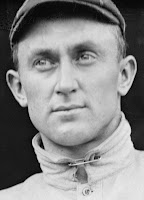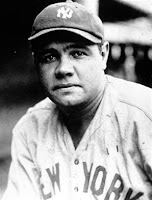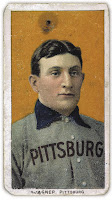 In a very rare show of bipartisan ship in the House of Representatives, Rep. Richard Hanna (R-NY24) introduced H.R. 2527, National Baseball Hall of Fame Commemorative Coin Act. Hanna, whose district includes Cooperstown, submitted the bill with 293 sponsors, including the entire New York delegation from both parties. This might be the first coin-related legislation to see action in the 112th congress.
In a very rare show of bipartisan ship in the House of Representatives, Rep. Richard Hanna (R-NY24) introduced H.R. 2527, National Baseball Hall of Fame Commemorative Coin Act. Hanna, whose district includes Cooperstown, submitted the bill with 293 sponsors, including the entire New York delegation from both parties. This might be the first coin-related legislation to see action in the 112th congress.
The National Baseball Hall of Fame and Museum opened in Cooperstown, New York on June 12, 1939. Its first inductees class include five payers who many consider amongst the greatest who have ever played professional baseball. These inductees were (in alphabetical order):
 Tyrus Raymond “Ty” Cobb, also known as “The Georgia Peach,” set 90 Major League Baseball Records including highest career batting average (.367) and most career batting titles (12) which he still holds today. His 24-year career was also memorable for his surly temperament and aggressive playing style. When he was voted in to National Baseball Hall of Fame on its inaugural ballot in 1936, he received 222 out of a possible 226 votes, the most of this entry class. The other four votes were probably from sportswriters Cobb made upset during the course of his career.
Tyrus Raymond “Ty” Cobb, also known as “The Georgia Peach,” set 90 Major League Baseball Records including highest career batting average (.367) and most career batting titles (12) which he still holds today. His 24-year career was also memorable for his surly temperament and aggressive playing style. When he was voted in to National Baseball Hall of Fame on its inaugural ballot in 1936, he received 222 out of a possible 226 votes, the most of this entry class. The other four votes were probably from sportswriters Cobb made upset during the course of his career. Walter “Big Train” Johnson played 21 years for the original Washington Senators, 1907-1927. Johnson is second in all time wins with 417 (Cy Young won 511) and is still the all-time career leader in shutouts with 110. Using scientific tests available at the time, Johnson’s fastball was clocked at over 91 miles per hour which was phenomenal for the time. His motion and fastball fooled many hitters, especially right handers. Many of his strikeout records lasted more than 50 years before being broken by future Hall of Famers Bob Gibson, Nolan Ryan, Steve Carlton, and Gaylord Perry.
Walter “Big Train” Johnson played 21 years for the original Washington Senators, 1907-1927. Johnson is second in all time wins with 417 (Cy Young won 511) and is still the all-time career leader in shutouts with 110. Using scientific tests available at the time, Johnson’s fastball was clocked at over 91 miles per hour which was phenomenal for the time. His motion and fastball fooled many hitters, especially right handers. Many of his strikeout records lasted more than 50 years before being broken by future Hall of Famers Bob Gibson, Nolan Ryan, Steve Carlton, and Gaylord Perry. Christy Mathewson holds the National League record for wins with 373. In 17 years, he won all but one of those games with the New York Giants. In 1916, Mathewson was traded to the Cincinnati Reds and became their manager. During his career, Mathewson was famous for his duels with Mordecai “Three Finger” Brown, mostly against the Chicago Cubs. Brown got the best of Mathewson 13-11 with one no-decision. Johnson’s career was cut short when he was accidentally gassed during World War I.
Christy Mathewson holds the National League record for wins with 373. In 17 years, he won all but one of those games with the New York Giants. In 1916, Mathewson was traded to the Cincinnati Reds and became their manager. During his career, Mathewson was famous for his duels with Mordecai “Three Finger” Brown, mostly against the Chicago Cubs. Brown got the best of Mathewson 13-11 with one no-decision. Johnson’s career was cut short when he was accidentally gassed during World War I. George Herman “Babe” Ruth, “the Bambino,” “the Sultan of Swat,” the former pitcher turned outfielder is largely credited for saving baseball after the Chicago Black Sox Scandal during the 1919 World Series. Baseball needed a new hero and Babe Ruth was there with a mighty bat. The sale of his contract from the Red Sox to the Yankees in December 1919 had been part of Red Sox lore and hung like an albatross until the BoSox won the World Series in 2004—which they beat the Yankees to get into the World Series after being down three games to one in the ALCS!
Babe Ruth was baseball’s first home run king. In 1921, Ruth hit 59 home runs while the Yankees shared the Polo Grounds with the Giants. That record stood until Ruth belted 60 for the “Murderer’s Row” team of 1927. It was a record that stood until Roger Maris hit 61 in 1961. His 714 career home runs served as a record until broken by Hank Aaron in 1974. Ruth’s .690 slugging percentage remains a record.
George Herman “Babe” Ruth, “the Bambino,” “the Sultan of Swat,” the former pitcher turned outfielder is largely credited for saving baseball after the Chicago Black Sox Scandal during the 1919 World Series. Baseball needed a new hero and Babe Ruth was there with a mighty bat. The sale of his contract from the Red Sox to the Yankees in December 1919 had been part of Red Sox lore and hung like an albatross until the BoSox won the World Series in 2004—which they beat the Yankees to get into the World Series after being down three games to one in the ALCS!
Babe Ruth was baseball’s first home run king. In 1921, Ruth hit 59 home runs while the Yankees shared the Polo Grounds with the Giants. That record stood until Ruth belted 60 for the “Murderer’s Row” team of 1927. It was a record that stood until Roger Maris hit 61 in 1961. His 714 career home runs served as a record until broken by Hank Aaron in 1974. Ruth’s .690 slugging percentage remains a record. Johannes Peter “Honus” Wagner was probably baseball’s first superstar. Playing most of his career with the Pittsburgh Pirates, Wagner won eight batting titles which is tied for the most in the National League with Tony Gwynn. One of the highlights of Wagner’s career was when the Pirates faced the Detroit Tigers in the 1909 World Series. The Tigers were lead by the 22-year old Ty Cobb. Vowing not to have the same poor showing as he did during the 1903 World Series, Wagner out hit Cobb .333 to .231 and stole six bases, setting a World Series record. At 35 years old, Wagner lead his Pirates to victory over the Tigers, 4-3. Wanger’s T206 Baseball card made by the American Tobacco Company is the most expensive baseball card in the world—only 57 are known to exist.
Johannes Peter “Honus” Wagner was probably baseball’s first superstar. Playing most of his career with the Pittsburgh Pirates, Wagner won eight batting titles which is tied for the most in the National League with Tony Gwynn. One of the highlights of Wagner’s career was when the Pirates faced the Detroit Tigers in the 1909 World Series. The Tigers were lead by the 22-year old Ty Cobb. Vowing not to have the same poor showing as he did during the 1903 World Series, Wagner out hit Cobb .333 to .231 and stole six bases, setting a World Series record. At 35 years old, Wagner lead his Pirates to victory over the Tigers, 4-3. Wanger’s T206 Baseball card made by the American Tobacco Company is the most expensive baseball card in the world—only 57 are known to exist.
There have been 205 former major leaguers, 27 executives, 35 Negro League players, 19 managers, and 9 umpires elected to the Hall of Fame. There are currently 63 living members. Exhibits include Women in Baseball, ¡Viva Baseball! celebrating baseball in Latin America and the Caribbean, and The Records Room that shows off the real equipment used to set Major League records.
Should the bill pass, it calls for the minting of 750,000 half-dollar clad coins, 400,000 $1 silver coins, and 50,000 $5 dollar gold coins in 2015. The sale of these coins will include a $35 surcharge for the gold coin, $10 for the silver dollar, and $5 for the clad half-dollar. The potential income of $9.5 million will be paid to the National Baseball Hall of Fame to help finance its operations.
According to the bill, the obverse design of the coin will require an open competition. “The competition shall be judged by an expert jury chaired by the Secretary and consisting of 3 members from the Citizens Coinage Advisory Committee who shall be elected by such Committee and 3 members from the Commission of Fine Arts who shall be elected by such Commission.” The bill said that the “Secretary shall determine compensation for the winning design, which shall be not less than $5,000.” Of course there is a catch. The bill says that the “Secretary may not accept a design for the competition unless a plaster model accompanies the design.”
For the reverse, the bill says the coins “shall depict a baseball similar to those used by Major League Baseball.”
But there is an interesting catch to the design specified in the bill. The bill wants the coin design “fashion[ed] similar to the 2009 International Year of Astronomy coins issued by Monnaie de Paris, the French (sic) Mint, so that the reverse of the coin is convex to more closely resemble a baseball and the obverse concave, providing a more dramatic display of the obverse design chosen.” This should give the U.S. Mint some use for the machinery they used to strike the 2009 Ultra High Relief Double Eagle Gold Coin.
With 293 co-sponsors from both sides of the aisle, there should be no reason for this this bill not to pass—but stranger things have happened with this congress already. The bill has been referred to the House Financial Services Committee where it will likely to be assigned to the Subcommittee on Domestic Monetary Policy and Technology chaired by Rep. Ron Paul (R-TX). In the “what could go wrong” category, Rep. Paul is not considered a friend to the U.S. Mint or its practices.
The bill has also been referred to the House Budget Committee who has its hands full with other matters. Budget Committee Chairman Rep. Paul Ryan (R-WI) is also known not to be a fan of the government.
Neither Paul or Ryan are co-sponsors of this bill. Maybe they can put aside their partisan differences like others who have co-sponsored the bill since baseball is something we can all agree on. As a long time baseball fan, I would buy these commemoratives. I hope congress gives me the chance!
Baseball Hall of Fame image courtesy of the National Baseball Hall of Fame and Museum.
All other pictures courtesy of Wikimedia.


1 Comment